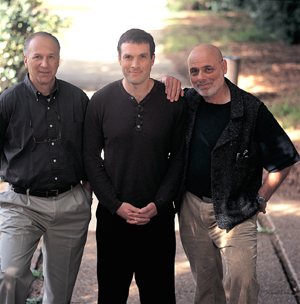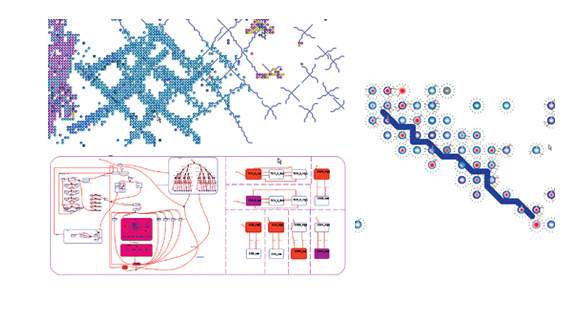Are you a journalist? Please sign up here for our press releases
Subscribe to our monthly newsletter:

The life stories of blood stem cells, rich in suspense and danger, could fill volumes. A new study at the Weizmann Institute of Science has come out with a dynamic model that, for the first time, captures these stories on film.
Every 15 minutes a stem cell travels from the bone marrow to the thymus gland, where it undergoes a grueling training period. Only a few survive. The training proceeds through several stations, each of which equips the cadet with the skills necessary for the next stage. The process is very risky: If the cadet goes to the wrong station it will die. If it goes to the right station yet performs incorrectly or receives too strong a stimulus it again will die. Those that survive – only 3% – become mature T cells, the top combatants of the immune system. What is the secret of their survival? Is it possible to forecast the survival chances of each cell? The factors determining life and death are many: a small change in the number of certain receptors on the cell, the level of expressed proteins, etc. Since the number of receptors and cells is very large, and the number of combinations they may form is even larger, the whole system is extremely complex. Until now, scientists have lacked the ability to obtain an integrated picture of this process without introducing gross over simplifications.
To overcome this problem, Prof. Irun Cohen of the Weizmann Institute’s Immunology Department collaborated with Prof. David Harel, Dean of the Mathematics and Computer Science Faculty. With their joint graduate student Sol Efroni they were able to build a dynamic model that describes the training process through animation. In other words, they took the script – an enormous amount of information accumulated through previous studies – and turned it into a moving picture of the working thymus. What’s more, it’s an interactive film, in which the scientists can change parts of the plot to see how varying circumstances affect the outcome.
Their approach, termed Reactive Animation (RA) was designed using Statecharts, a method developed by Harel around 20 years ago to facilitate the management of complex computerized systems (see box).
In watching the animated drama, the scientists were able to piece together how different circumstances (such as changes in the stem cell population due to cell death or birth) affect the training results. They were surprised to discover several previously unsuspected phenomena. It turns out, for example, that during training the thymus cells compete with one another in Darwinian fashion, and even interfere with one another’s performance.
To examine the importance of this competition, the scientists used the dynamic RA model to decrease the level of competitiveness among the cells. The result: The structure of the thymus gland became distorted and its normal function ceased. In other words, the competition among the cells is a critical phenomenon without which T-cell training cannot take place.
To assess the reliability of their program, the scientists designed an experiment in which they entered the data characterizing the starting point of the thymus cell-training program. They then ran the program without interruption (i.e. without introducing new circumstances) to see whether the outcome would correspond to the training results occurring naturally in the body. The result was a direct match.
The model’s ability to describe the behavior of this highly complex biological system will enable experimental biologists to examine theories relating to immune function, choosing those that best conform to reality. “A better understanding of the factors controlling the T-cell training process could one day be used to promote desirable immune responses, such as blocking autoimmune diseases and reducing the body’s rejection of transplants,” says Cohen.
RA could also prove helpful to the study of embryogenesis – a leading field in biology dedicated to exploring the remarkable process by which a single fertilized egg develops into a complex three-dimensional organism. One of the team’s findings was that it is possible to generate a detailed model of the thymus gland – its form and function – merely by providing the computer program with information about the gland’s cells, the way these cells interact, and the chemicals they secret. Future studies might apply RA in this fashion to study the development of other glands or even organs. The idea, says Cohen, would be to use RA to examine how the body’s components “speak” to and influence one another to orchestrate the development of the lungs, heart and other organs – all striking in their architectural waltz of form and function.

Statecharts provides a visual description of the behavior of big, reactive systems such as those present in airplanes, automobiles and phone networks. Recently, it has been used to describe biological systems. The method presents all known possibilities and the relations between them in systematic, hierarchical diagrams. A software tool called Rhapsody, devised by Prof. Harel with a company called I-Logix, implements and supports Statecharts.
In RA, the diagrams produced using Statecharts were programmed to interface in a novel way with Flash animation.
Prof. Cohen’s research is supported by the Robert Koch Minerva Center for Research in Autoimmune Disease; Mr. and Mrs. Samuel Theodore Cohen, Chicago, IL; and the Minna James Heineman Stiftung. He is the incumbent of the Helen and Morris Mauerberger Professorial Chair in Immunology.